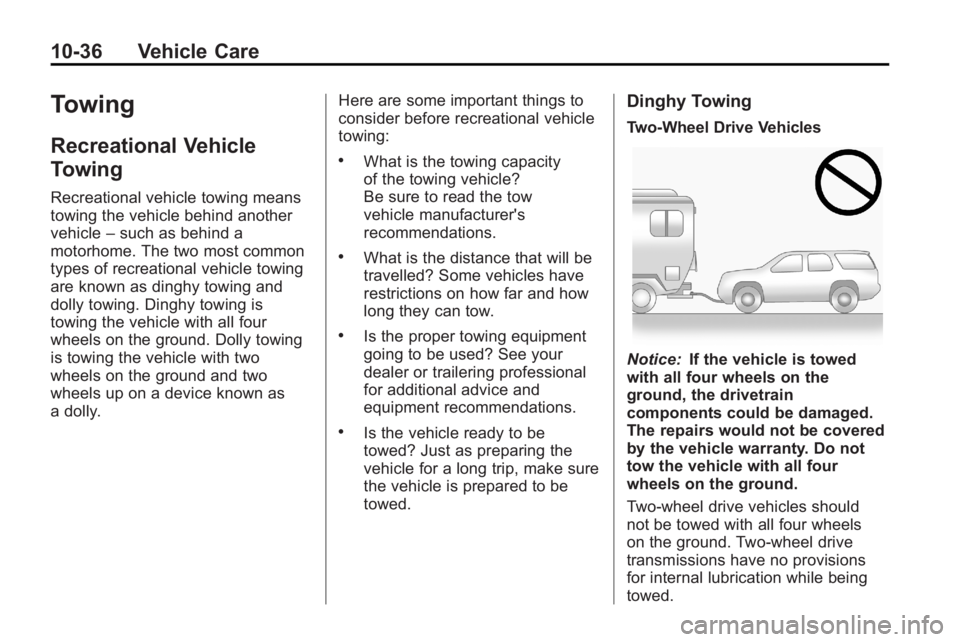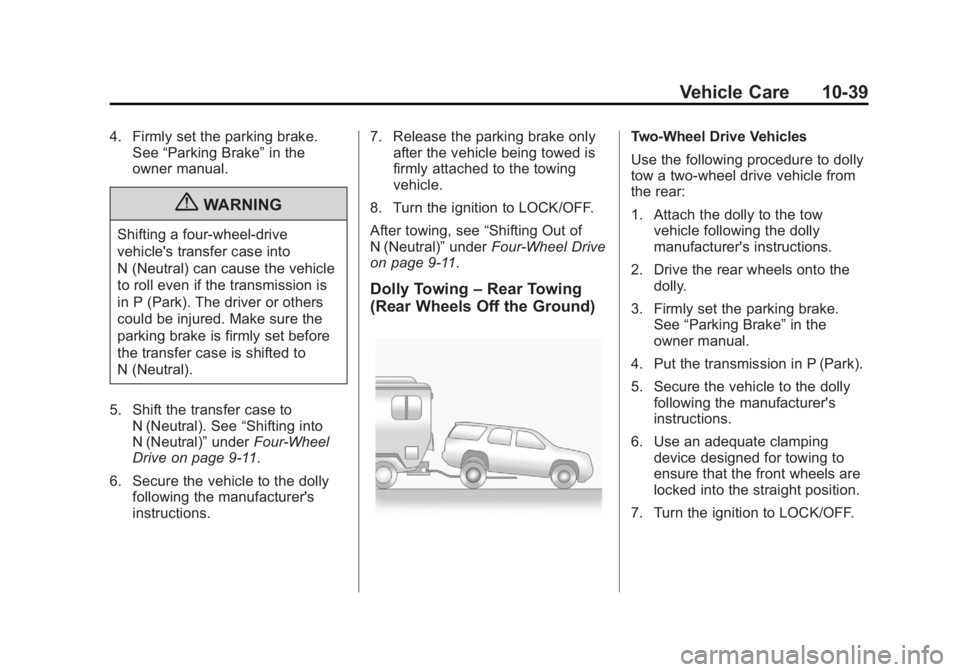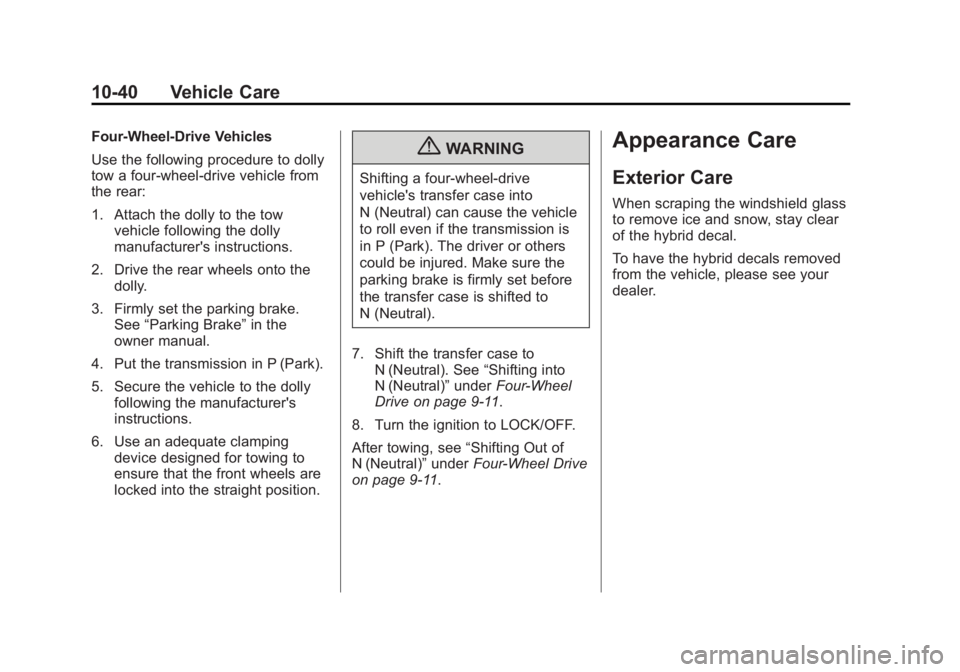Page 80 of 94

10-36 Vehicle Care
Towing Recreational Vehicle
Towing Recreational vehicle towing means
towing the vehicle behind another
vehicle – such as behind a
motorhome. The two most common
types of recreational vehicle towing
are known as dinghy towing and
dolly towing. Dinghy towing is
towing the vehicle with all four
wheels on the ground. Dolly towing
is towing the vehicle with two
wheels on the ground and two
wheels up on a device known as
a dolly. Here are some important things to
consider before recreational vehicle
towing: .
What is the towing capacity
of the towing vehicle?
Be sure to read the tow
vehicle manufacturer's
recommendations. .
What is the distance that will be
travelled? Some vehicles have
restrictions on how far and how
long they can tow. .
Is the proper towing equipment
going to be used? See your
dealer or trailering professional
for additional advice and
equipment recommendations. .
Is the vehicle ready to be
towed? Just as preparing the
vehicle for a long trip, make sure
the vehicle is prepared to be
towed. Dinghy Towing Two-Wheel Drive Vehicles
Notice: If the vehicle is towed
with all four wheels on the
ground, the drivetrain
components could be damaged.
The repairs would not be covered
by the vehicle warranty. Do not
tow the vehicle with all four
wheels on the ground.
Two-wheel drive vehicles should
not be towed with all four wheels
on the ground. Two-wheel drive
transmissions have no provisions
for internal lubrication while being
towed.
Page 81 of 94

Vehicle Care 10-37Four-Wheel Drive Vehicles
Use the following procedure to
dinghy tow a four-wheel drive
vehicle:
1. Position the vehicle being towed
behind the tow vehicle and shift
the transmission to P (Park).
2. Turn the engine off and firmly set
the parking brake. See “ Parking
Brake ” in the owner manual.
3. Securely attach the vehicle
being towed to the tow vehicle. { WARNINGShifting a four-wheel-drive
vehicle's transfer case into
N (Neutral) can cause the vehicle
to roll even if the transmission is
in P (Park). The driver or others
could be injured. Make sure the
parking brake is firmly set before
the transfer case is shifted to
N (Neutral).
4. Shift the transfer case to
N (Neutral). See “ Shifting into
N (Neutral) ” under Four-Wheel
Drive on page 9 ‑ 11 for the
proper procedure to select the
Neutral position for the vehicle.
5. Release the parking brake only
after the vehicle being towed is
firmly attached to the towing
vehicle. 6. For vehicles without a column
lock, turn the ignition to LOCK/
OFF and remove the key.
The steering wheel will still turn.
7. For vehicles with a column lock,
remove the DLIS fuse from the
engine compartment fuse block
and turn the ignition to the
ACC/ACCESSORY position.
If the ignition is turned to the
ON/RUN position, the battery
will be drained.
Page 82 of 94
10-38 Vehicle Care Dolly Towing – Front Towing
(Front Wheels Off the Ground) Two-Wheel Drive Vehicles
Notice: If a two-wheel-drive
vehicle is towed with the rear
wheels on the ground, the
transmission could be damaged.
The repairs would not be covered
by the vehicle warranty. Never
tow the vehicle with the rear
wheels on the ground. Two-wheel drive vehicles should not
be towed with the rear wheels on
the ground. Two-wheel drive
transmissions have no provisions
for internal lubrication while being
towed.
To dolly tow a two ‐ wheel ‐ drive
vehicle, the vehicle must be towed
with the rear wheels on the dolly.
See “ Rear Towing (Rear Wheels Off
the Ground) ” later in this section for
more information. Four-Wheel Drive Vehicles
Use the following procedure to dolly
tow a four-wheel drive vehicle from
the front:
1. Attach the dolly to the tow
vehicle following the dolly
manufacturer's instructions.
2. Drive the front wheels onto the
dolly.
3. Shift the transmission to
P (Park).
Page 83 of 94

Black plate (39,1)Cadillac Escalade Hybrid - 2011
Vehicle Care 10-394. Firmly set the parking brake.
See “ Parking Brake ” in the
owner manual.
{ WARNINGShifting a four-wheel-drive
vehicle's transfer case into
N (Neutral) can cause the vehicle
to roll even if the transmission is
in P (Park). The driver or others
could be injured. Make sure the
parking brake is firmly set before
the transfer case is shifted to
N (Neutral).
5. Shift the transfer case to
N (Neutral). See “ Shifting into
N (Neutral) ” under Four-Wheel
Drive on page 9 ‑ 11 .
6. Secure the vehicle to the dolly
following the manufacturer's
instructions. 7. Release the parking brake only
after the vehicle being towed is
firmly attached to the towing
vehicle.
8. Turn the ignition to LOCK/OFF.
After towing, see “ Shifting Out of
N (Neutral) ” under Four-Wheel Drive
on page 9 ‑ 11 .
Dolly Towing – Rear Towing
(Rear Wheels Off the Ground) Two ‐ Wheel Drive Vehicles
Use the following procedure to dolly
tow a two-wheel drive vehicle from
the rear:
1. Attach the dolly to the tow
vehicle following the dolly
manufacturer's instructions.
2. Drive the rear wheels onto the
dolly.
3. Firmly set the parking brake.
See “ Parking Brake ” in the
owner manual.
4. Put the transmission in P (Park).
5. Secure the vehicle to the dolly
following the manufacturer's
instructions.
6. Use an adequate clamping
device designed for towing to
ensure that the front wheels are
locked into the straight position.
7. Turn the ignition to LOCK/OFF.
Page 84 of 94

Black plate (40,1)Cadillac Escalade Hybrid - 2011
10-40 Vehicle Care Four ‐ Wheel ‐ Drive Vehicles
Use the following procedure to dolly
tow a four-wheel-drive vehicle from
the rear:
1. Attach the dolly to the tow
vehicle following the dolly
manufacturer's instructions.
2. Drive the rear wheels onto the
dolly.
3. Firmly set the parking brake.
See “ Parking Brake ” in the
owner manual.
4. Put the transmission in P (Park).
5. Secure the vehicle to the dolly
following the manufacturer's
instructions.
6. Use an adequate clamping
device designed for towing to
ensure that the front wheels are
locked into the straight position. { WARNINGShifting a four-wheel-drive
vehicle's transfer case into
N (Neutral) can cause the vehicle
to roll even if the transmission is
in P (Park). The driver or others
could be injured. Make sure the
parking brake is firmly set before
the transfer case is shifted to
N (Neutral).
7. Shift the transfer case to
N (Neutral). See “ Shifting into
N (Neutral) ” under Four-Wheel
Drive on page 9 ‑ 11 .
8. Turn the ignition to LOCK/OFF.
After towing, see “ Shifting Out of
N (Neutral) ” under Four-Wheel Drive
on page 9 ‑ 11 .Appearance Care Exterior Care When scraping the windshield glass
to remove ice and snow, stay clear
of the hybrid decal.
To have the hybrid decals removed
from the vehicle, please see your
dealer.
Page 92 of 94

Black plate (2,1)Cadillac Escalade Hybrid - 2011
i-2 INDEX
FFlat Tire . . . . . . . . . . . . . . . . . . . . . . 10-23
Fluid
Automatic Transmission . . . . . . 10-6
Four-Wheel Drive
Transfer Case . . . . . . . . . . . . . . . 9-11
Power Steering . . . . . . . . . . . . . 10-13
Four-Wheel Drive . . . . . . . 10-14, 9-11
Fuel Economy Gauge . . . . . . . . . . 5-3
Fuses
Engine Compartment
Fuse Block . . . . . . . . . . . . . . . . 10-15
Fuses and Circuit
Breakers . . . . . . . . . . . . . . . . . . 10-15
GGauges
Fuel Economy . . . . . . . . . . . . . . . . . 5-3
Tachometer . . . . . . . . . . . . . . . . . . . . 5-3 H Heater
Engine Coolant . . . . . . . . . . . . . . . . 9-4
Heating and Air Conditioning . . . 8-1
High Voltage Devices and
Wiring . . . . . . . . . . . . . . . . . . . . . . . 10-15
I Instrument Cluster . . . . . . . . . . . . . . 5-2
Introduction . . . . . . . . . . . . . . . . . . . ii, 7-1
J Jump Starting . . . . . . . . . . . . . . . . . 10-31
L Lights
Charging System . . . . . . . . . . . . . . 5-4
Engine Oil Pressure . . . . . . . . . . . 5-4 M Maintenance Schedule
Recommended Fluids and
Lubricants . . . . . . . . . . . . . . . . . . . 11-2
Scheduled Maintenance . . . . . . 11-1
Transfer Case . . . . . . . . . . . . . . . . 9-11
Manual Mode . . . . . . . . . . . . . . . . . . 9-10
Messages
Battery Voltage and
Charging . . . . . . . . . . . . . . . . . . . . . 5-6
Brake System . . . . . . . . . . . . . . . . . 5-6
Door Ajar . . . . . . . . . . . . . . . . . . . . . . 5-6
Engine Oil . . . . . . . . . . . . . . . . . . . . . 5-7
Service Vehicle . . . . . . . . . . . . . . . . 5-7
Transmission . . . . . . . . . . . . . . . . . . 5-7
Vehicle . . . . . . . . . . . . . . . . . . . . . . . . 5-5
O Oil
Messages . . . . . . . . . . . . . . . . . . . . . 5-7
Pressure Light . . . . . . . . . . . . . . . . . 5-4
Page:
< prev 1-8 9-16 17-24